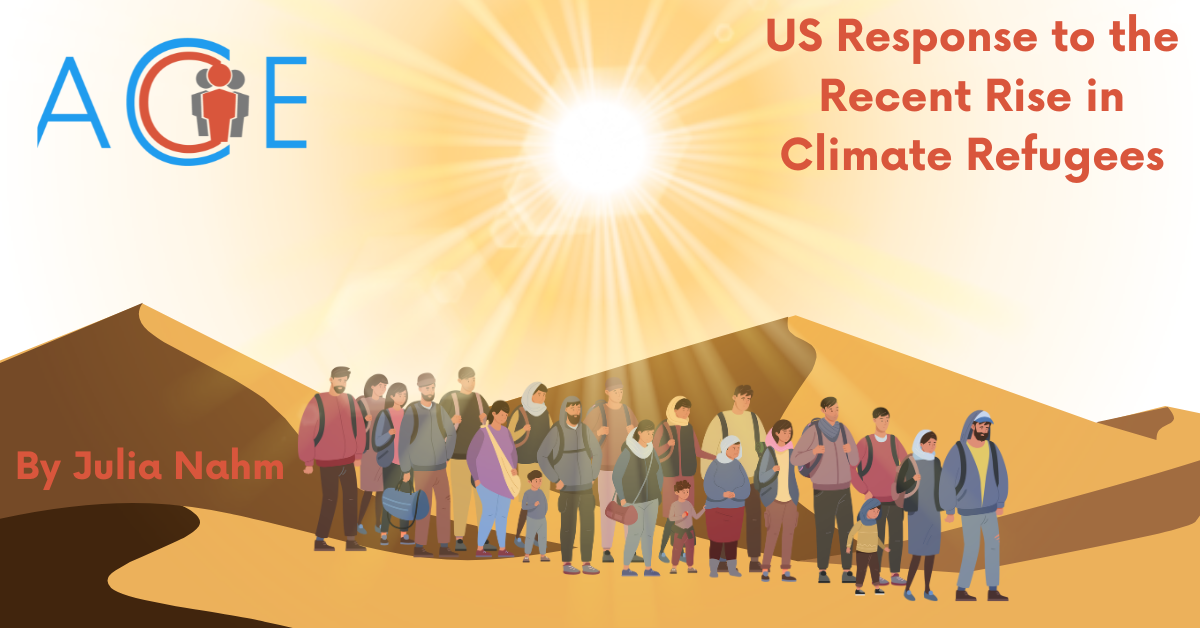Introduction
As global temperatures rise, climate change is causing millions of people to be displaced from their homes each year. This phenomenon, known as “climate refugees,” is driven by flooding, fires, natural disasters, and resource scarcity. The increasing number of climate refugees is leading to intensified migration patterns across international borders, posing economic, social, and political challenges globally. It is estimated that by 2050, about 1.2 billion people are at risk of displacement due to climate disasters. Addressing this worldwide threat of displacement requires understanding the problem and implementing proposed solutions.
Defining the Problem
In the United States, climate refugees from Central and Latin America, as well as internally displaced climate refugees, are significantly impacting migration patterns. Rising sea levels and increased natural disasters have already forced thousands of Americans to relocate within the country. Experts project that about 162 million Americans, nearly half the population, may experience a decline in their environmental quality, leading to increased migration flows. Additionally, citizens of Latin and Central American countries affected by extreme weather are seeking asylum at the U.S. border. In the most extreme climate scenarios, experts estimate that over 30 million migrants could head towards the U.S. border in the next 30 years.
Climate migration flows are expected to impact both the United States and Europe, with Europe likely to receive higher numbers of climate refugees. The countries most often left by climate migrants are primarily in Sub-Saharan Africa and the Middle East and North Africa region. The influx of migrants poses economic and geopolitical challenges for host regions. European countries like Greece and Italy have already faced strains on economic resources, affecting their social and political spheres. These estimates underscore the severity of the climate refugee issue on an international scale.
While global migrant flows are increasing, the critical issue lies in how international governments respond to these numbers. Climate refugees, facing homelessness and food insecurity, are on the frontlines of the climate emergency, often lacking resources to adapt to harsh environments. The influx of migrants strains host countries economically and politically, as they struggle to provide essential resources like housing, food, water, and safety. Disagreements over refugee rights can lead to political turmoil, posing a threat to the overall stability of host countries.
The main challenge governments face when dealing with climate refugees is legal. According to international law, a refugee is someone who faces persecution based on specific grounds, but climate refugees were not considered during the writing of refugee protections. As a result, they lack internationally recognized legal status as refugees and do not have a real right to asylum. This legal gap hinders governments from adequately addressing the growing number of climate refugees.
The International Response
The EU recognizes climate migration as a strategic issue and calls for funding and responses from member countries. The European Parliament has acknowledged the connection between climate change and migration, defining the climate crisis as one of the most important issues in the EU. A team of researchers has been designated to investigate the issue and propose an approach to address climate-induced displacement and migration. However, there is currently no EU legislation specifically providing asylum for climate refugees.
In 2021, President Biden published a progressive report officially correlating climate change and migration, marking a significant shift in U.S. government policy. This report signaled the government’s willingness to lead in climate migration legislation internationally. Additionally, the Biden Administration expanded Temporary Protected Status (TPS) in 2021, a status that offers temporary protection from deportation for refugees from countries facing war, natural disasters, or other crises. While TPS currently benefits refugees from certain countries like El Salvador and Haiti, experts argue that expanding TPS to include more climate refugees would be a positive step in addressing climate migration flows. Overall, these initiatives demonstrate the U.S. government’s commitment to finding solutions for climate refugees.
The US government has taken proactive steps to address internal migrant flows through national programs and funding. The 2021 White House report outlines these efforts, which include building local and national capacity to use climate information in decision-making, supporting adaptation to climate change impacts, and assisting migrants, displaced individuals, and host communities. Additionally, the US provides funding to organizations like the UNHCR, Red Cross, displacement monitoring centers, and others working with climate refugees. These initiatives align with the Biden administration’s mission to help climate refugees seek asylum and safety, while also promoting education and infrastructure to support American communities in a changing climate.
Pros and Cons of US Response
The US government’s policies reflect a committed response to the prevalence of climate change and its impact on migration flows. The expansion of TPS by the Biden administration signals a dedicated interest in addressing the issue and exploring potential solutions. However, it is crucial for governments worldwide to recognize the legal status of climate refugees. The United States has the opportunity to collaborate with global powers to find comprehensive solutions to climate migration. While TPS is a positive step, it remains a temporary measure with eligibility restrictions. Overall, while the US response is proactive, there is a need for more robust legislation to address the growing challenge of climate-induced migrant flows effectively.


